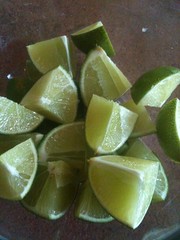
8 slices per lime.
Oh yeah? I just cut 4 limes, so how many slices are there?
36.
36, huh? How'd you come up with that?
8 and 8 is 16 and 16 times two is...no wait, 34. There's 34 slices.
Alright, explain that one then.
*Begins using finger and countertop as if it's chalk and slate*
No, no, no. It's 32. 32 slices.
Why?
Well it has to be even.
*teachable moment antennae go up*
Oh? Why even?
16 plus 16 has to be even because an even plus an even is an even.
You sure?
Yeah. Even plus even is even and odd plus odd is even too. For example, 8 plus 8 is 16. Even. And 7 plus 7 is 14. Even.
So how do we get an odd?
We get those by adding an even plus an odd.
Nuh uh.
Yeah, lemme show you.
*And he does*
You know, this is just too easy. Math is all over the place around here. I'm a big fan of WCYDWT and all, but I've always struggled with running into a great problem that fits something I have to teach. But since we've decided to take over the education of our children, I don't care what fits. If it's interesting, we're talking about it.
The best part of this is that I don't even have to bring in pictures of hot dogs and buns in order to teach LCM. I can actually have that conversation with my son in the grocery store on July 3 because we really don't want to have food go to waste.
That's it! I'm homeschooling my students next year.





3 comments:
Now how can we get more parents reading your blog? Even those who don't homeschool?
Who knows? The blogging community is pretty self selecting. I doubt I'm saying anything that y'all wouldn't do with your own kids. (except Jason, of course. He needs a tutor to read this math-y stuff)
Fun! And asking your children how they figured something out is just amazing--they love it that you're paying attention to them and what they think.
OK--now I get to tell one of my favorite stories. I was volunteering in my daughter's 3rd? 4th? grade Montessori classroom one day, and I was working with her and two other kids who were doing this big multiplication problem with manipulatives, and there were too many 4x5's in the problem, and we ran out of 5's, so I asked the kids what we could use because we didn't have enough 5's (5's are a set of 5 blue(?) beads fused together). So my daughter came up with using 2's and 3's to replace the 5's (distributive law!), and another girl came up with using five 4's for 4x5, and she even showed how you could put the four 5's together to make an array, and how you could make the same array by using five 4's instead (very cool thought-of-by-herself explanation of the commutative law!)-the remaining child wasn't quite so sure about those ways of doing it, but he was comfortable with replacing each of the 5's with five 1's (we had 3 sets of 4x5 left in the problem so we used each of the ways for one of the places). If you know what to look for, and you have the luxury of paying attention to just a few children at a time, it's amazing what math just happens!
Post a Comment